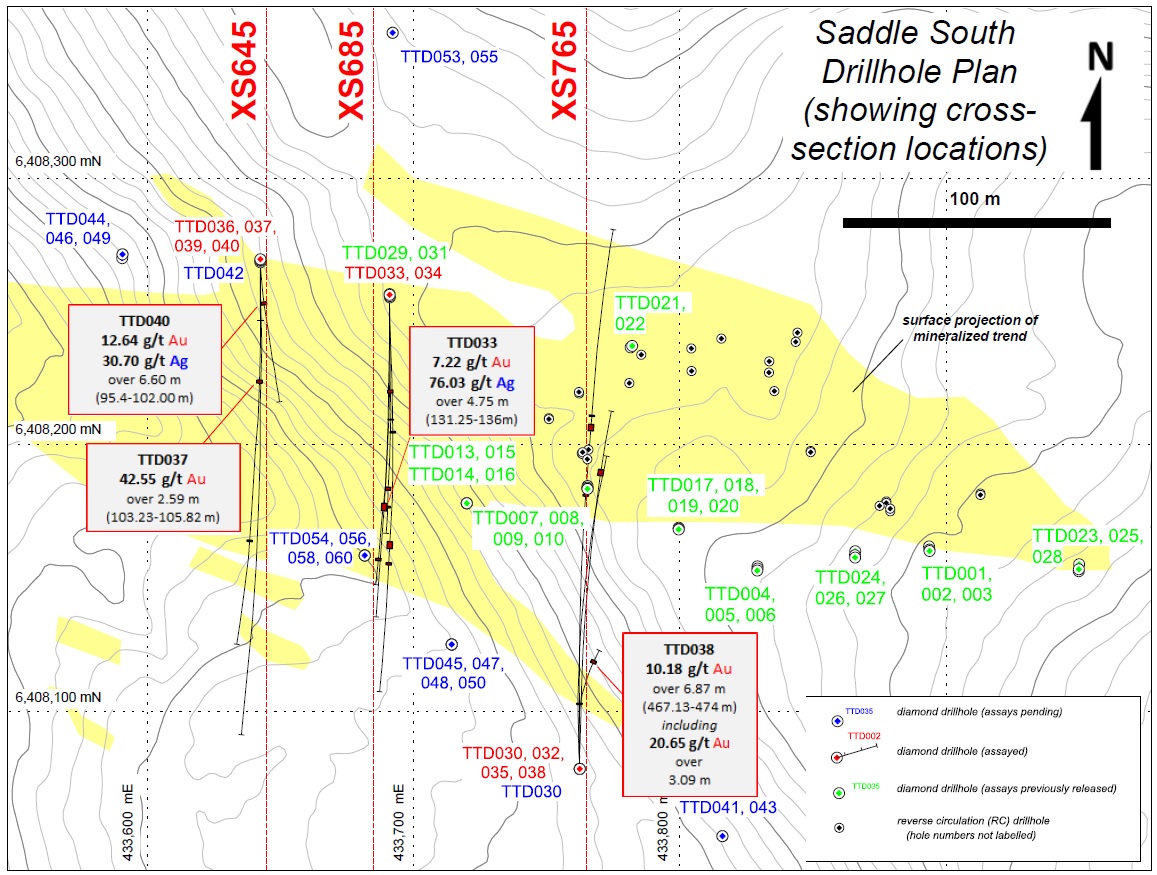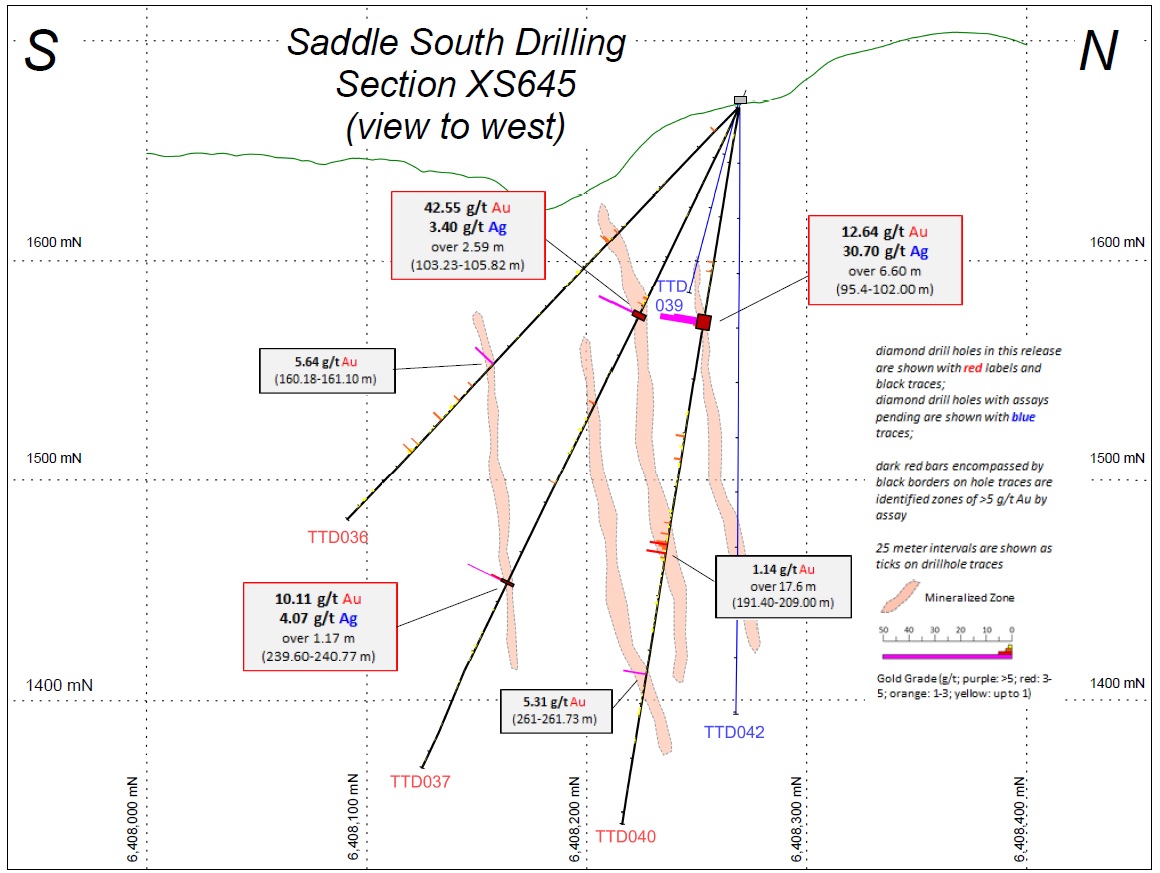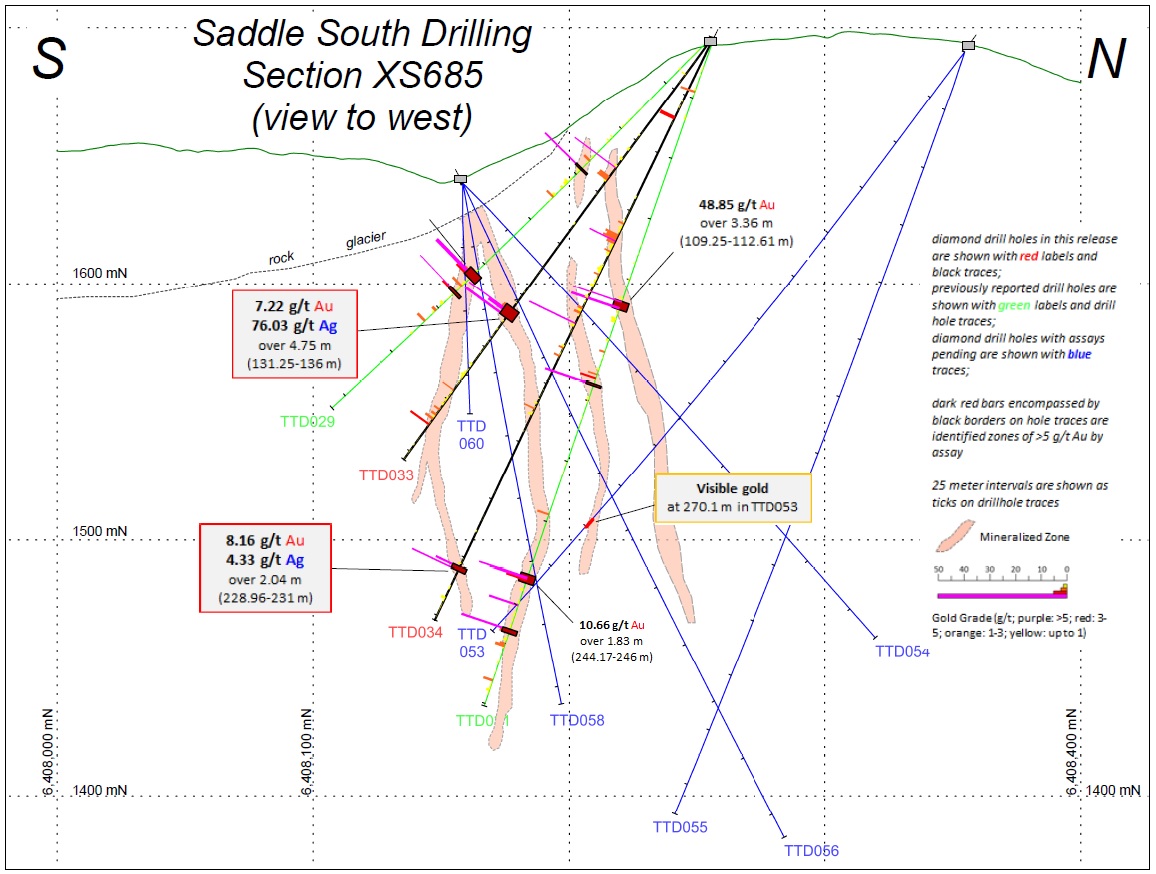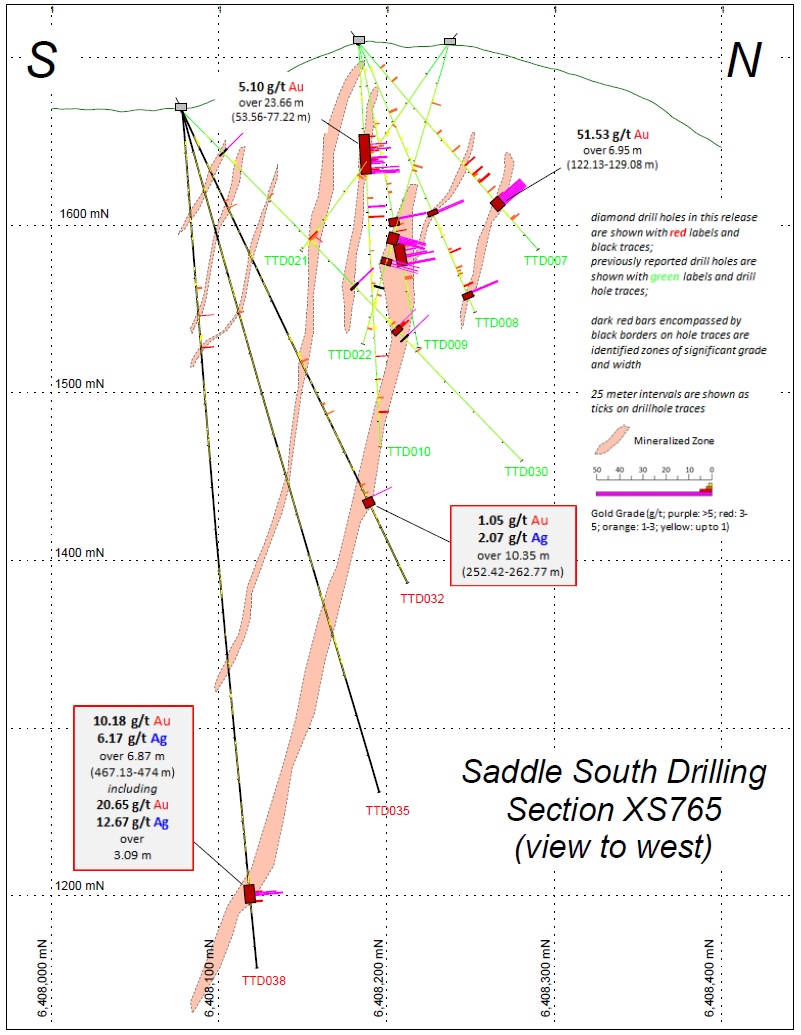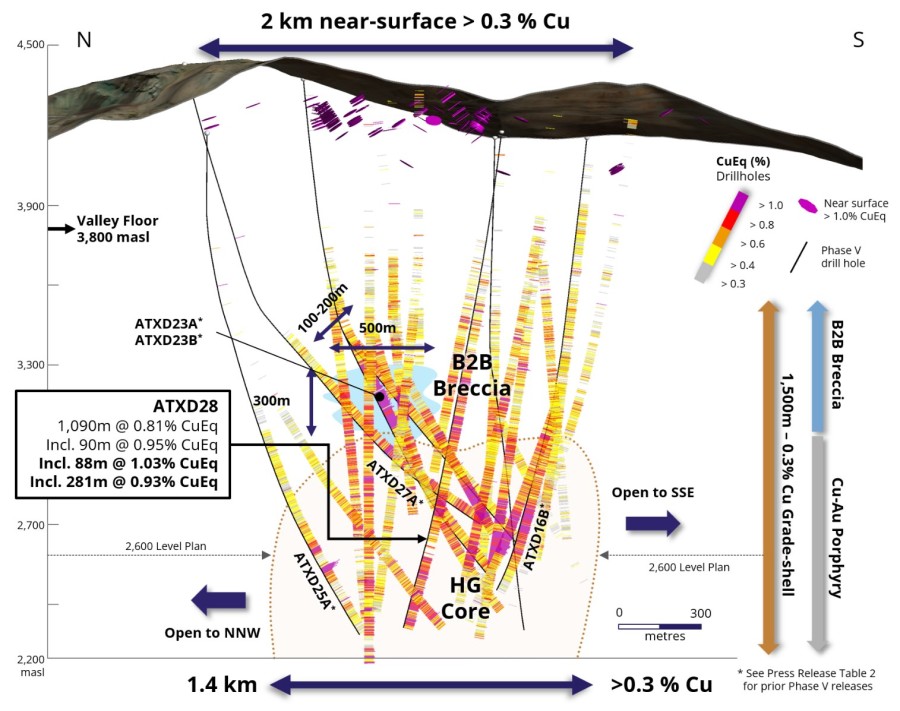VANCOUVER, BRITISH COLUMBIA--(Marketwired - Nov. 8, 2017) - GT Gold Corp. ("GT Gold" or the "Company") (TSX VENTURE:GTT) is pleased to report continued high-grade assays from drilling at its Saddle gold discovery, located 10 kilometres off highway 37 on the Company's 100%-owned Tatogga property in northwestern British Columbia, Canada. Results for 9 Saddle South core holes are reported in this news release. Of particular note, hole TTD038 has extended gold mineralization to approximately 500 metres down-dip from surface intersecting 10.18 g/t Au over 6.87 metres, confirming expectations conveyed by visuals and XRF readings (see news release dated Sept. 18). Mineralization continues to be open at depth and along strike in both directions.
This year a total of 1,527 metres of RC drilling in 28 holes, and 16,180 metres of core drilling in 64 core holes were completed at the Saddle discovery. Assays for an additional 24 core holes (20 from Saddle South, 4 from Saddle North) are pending.
Highlights from the new results include:
Saddle South:
- 42.55 g/t Au over 2.59 metres from 103.23 metres (TTD037)
- Including 98.80 g/t Au over 1.11 metres from 103.89 metres
- 12.64 g/t Au & 30.7 g/t Ag over 6.60 metres from 95.40 metres (TTD040)
- Including 39.18 g/t Au & 139.59 g/t Ag over 1.18 metres from 97.82 metres
- 10.18 g/t Au over 6.87 metres from 463.23 metres (TTD038)
- Including 20.65 g/t Au over 3.09 metres from 467.13 metres
Maps of drill hole locations and drill sections are included below. The same images, along with photos of core, camp and drill sites, can be obtained from the "Downloads" portion of the Company's homepage (scroll down, left) at www.gtgoldcorp.ca.
Comments:
"Saddle South continues to deliver excellent high-grade results," says Kevin Keough, President & CEO. "And now we have confirmed that mineralization continues at depth. In only four months we have accomplished 1,500 metres of RC drilling and 16,000 metres of core drilling and have achieved one of the most significant new gold discoveries of the past several years in B.C. The target area continues to offer terrific exploration upside."
Table 1 - Saddle Diamond Drill Program Assay Results: Refer to drilling plan view.
| Hole Number | From (m) |
To (m) |
Interval (m) |
Uncut Grade g/t Au |
Uncut Grade g/t Ag |
Comments | Zone | |||
| TTD032 | 252.42 | 262.77 | 10.35 | 1.05 | 2.07 | Step-back | Saddle South | |||
| Including | 256.00 | 256.55 | 0.55 | 8.29 | 13.20 | |||||
| TTD033 | 131.25 | 136.00 | 4.75 | 7.22 | 76.03 | West step-out | Saddle South | |||
| Including | 132.81 | 133.36 | 0.55 | 26.50 | 96.30 | |||||
| And | 135.00 | 136.00 | 1.00 | 11.15 | 4.90 | |||||
| TTD034 | 228.96 | 231.00 | 2.04 | 8.16 | 4.33 | West step-out | Saddle South | |||
| Including | 230.38 | 231.00 | 0.62 | 19.20 | 9.40 | |||||
| TTD035 | No significant intercepts | Step-back, undercut to 032 | Saddle South | |||||||
| TTD036 | No significant intercepts | West step-out, overcut to 037 | Saddle South | |||||||
| TTD037 | 103.23 | 105.82 | 2.59 | 42.55 | 3.40 | Undercut to 036 | Saddle South | |||
| Including | 103.89 | 105.00 | 1.11 | 98.80 | 6.40 | |||||
| And | 239.60 | 240.77 | 1.17 | 10.11 | 4.07 | |||||
| TTD038 | 467.13 | 474.00 | 6.87 | 10.18 | 6.17 | Deep stepback | Saddle South | |||
| Including | 467.13 | 470.22 | 3.09 | 20.65 | 12.67 | |||||
| TTD039 | Abandoned in fault gouge at 90 metres - no significant intercepts | Saddle South | ||||||||
| TTD040 | 95.40 | 102.00 | 6.60 | 12.64 | 30.70 | West step-out | Saddle South | |||
| Including | 97.82 | 99.00 | 1.18 | 39.18 | 139.59 | |||||
Significant intercepts for 9 diamond drill holes, arranged by hole number (see plan view and three cross-sections) are reported above. Widths reported are drilled core lengths. True widths are estimated to be approximately 90% of drilled lengths for minus 45-degree holes, 70% for minus 70-degree holes, and about 50% for minus 85-degree holes.
Table 2 - Saddle Diamond Drill Hole Details: Key information for the above 9 diamond drill holes, arranged by hole number (see plan view), is reported below. Refer to drilling plan view for location of sections.
| Hole Number | Azimuth (degrees) |
Dip (degrees) |
Elevation (m) |
Length (m) |
UTM E | UTM N | Section |
| TTD032 | 0 | -65 | 1668 | 312.00 | 433763 | 6408078 | 765 |
| TTD033 | 180 | -54 | 1695 | 204.00 | 433688 | 6408258 | 685 |
| TTD034 | 180 | -64 | 1695 | 252.00 | 433688 | 6408258 | 685 |
| TTD035 | 0 | -75 | 1668 | 423.00 | 433763 | 6408078 | 765 |
| TTD036 | 180 | -45 | 1673 | 258.00 | 433641 | 6408270 | 645 |
| TTD037 | 180 | -65 | 1673 | 333.00 | 433641 | 6408270 | 645 |
| TTD038 | 0 | -85 | 1668 | 513.00 | 433763 | 6408078 | 765 |
| TTD039 | 180 | -75 | 1673 | 90.00 | 433641 | 6408270 | 645 |
| TTD040 | 180 | -80 | 1673 | 324.00 | 433641 | 6408270 | 645 |
Saddle South Geology and Mineralization
Charlie Greig, Vice President, Exploration, states: "The mineralization at Saddle South varies somewhat in style, but we believe it is essentially of intermediate sulphidation epithermal type. The highest-grade sections are characterized by semi-massive to massive quartz-carbonate sulphide veins and vein-breccias dominated by pyrite with subordinate sphalerite, galena, chalcopyrite and local sulphosalts. Closely associated are narrower quartz-carbonate-pyrite and pyrite veins and veinlets; the former are commonly well-banded, multi-stage veins with well-developed coliform textures. Also, closely associated with all sulphide-rich vein styles present at Saddle, are disseminations and somewhat coarser-grained irregular aggregates of pyrite that typically occur in halos around the veins - this style of mineralization also appears to be gold-bearing and, where well-developed, it provides excellent wallrock 'support' for vein intersections. Alteration associated with the veins and their pyritic halos includes carbonate, Fe-rich chlorite, sericite, and silica with peripheral chlorite-Fe carbonate alteration.
"The mineralized zones appear to follow an overall east-west trend along a steeply dipping structure, or structures, and this zone also appears to be the locus for emplacement of a series of largely post-mineral felsic, intermediate and mafic dykes. Mineralization, dykes and the host structure cut and are at a high angle to the moderately to steeply east-northeast dipping host fragmental volcanic and volcaniclastic rocks, and local flows, which are typically characterized by the presence of fine-grained hornblende and feldspar phenocrysts in both matrix, fragments, and clasts. The host rocks have been mapped previously as part of the Lower to Middle Jurassic Hazelton Group, which hosts many significant mineral deposits in the Golden Triangle of northwestern British Columbia. A deformational overprint also characterizes the host rocks, mineralization, and many of the dykes. The host rocks are of low metamorphic rank, but in the vicinity of mineralized zones they are commonly well-foliated. All the rocks, including the mineralized ones and the younger dykes, are cut by a variety of brittle faults and fractures, and by common, discontinuous and generally narrow calcite veins. In spite of this, the mineralized zones appear to display good continuity."
QA/QC Procedures
GT Gold has implemented a rigorous quality assurance / quality control (QA/QC) program to ensure best practices in sampling and analysis of RC chips and diamond drill core, the details of which can be viewed on the Company's website at www.gtgoldcorp.ca/projects/tatogga/.
All assays are performed by ALS Canada Ltd., with sample preparation carried out at the ALS facility in Terrace, BC, and assays at the North Vancouver laboratory. Assay values are uncut. Assay results presented below are fire assay results only. For gold, fire assays are performed as per ALS protocol Au-AA26 (0.01-100.00 g/t Au) using 50 grams of sample with assays equal to or greater than 5 g/t Au calculated gravimetrically, and lower-grade samples measured by (AA) atomic absorption.
Charles J. Greig, M.Sc., P.Geo., Vice President, Exploration for GT Gold and the Company's Qualified Person as defined by NI 43-101, has reviewed and approved the technical information in this news release.


